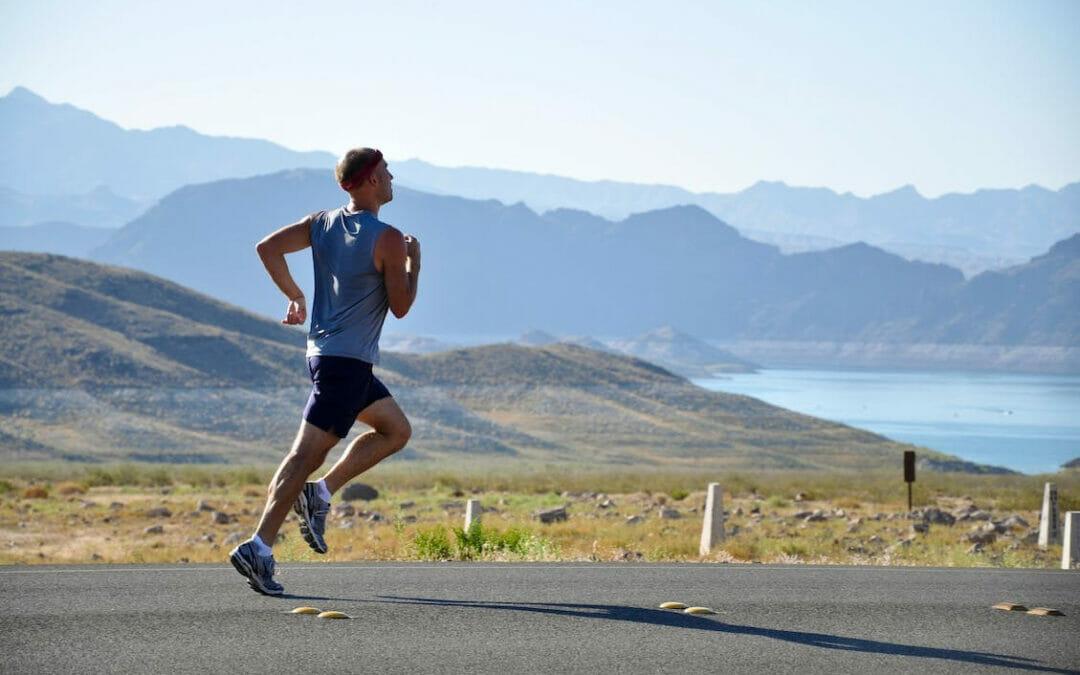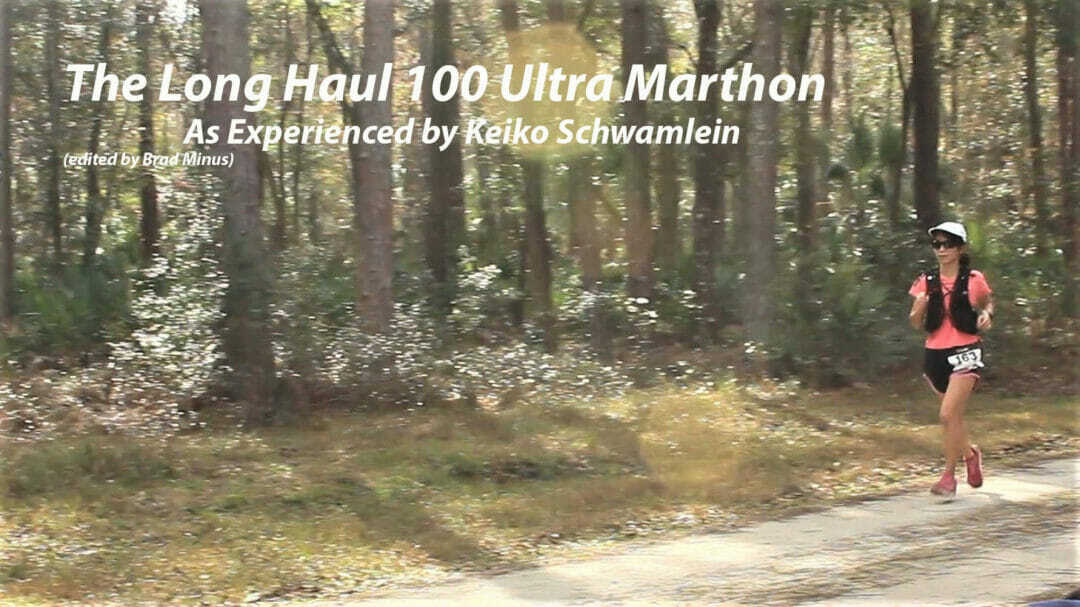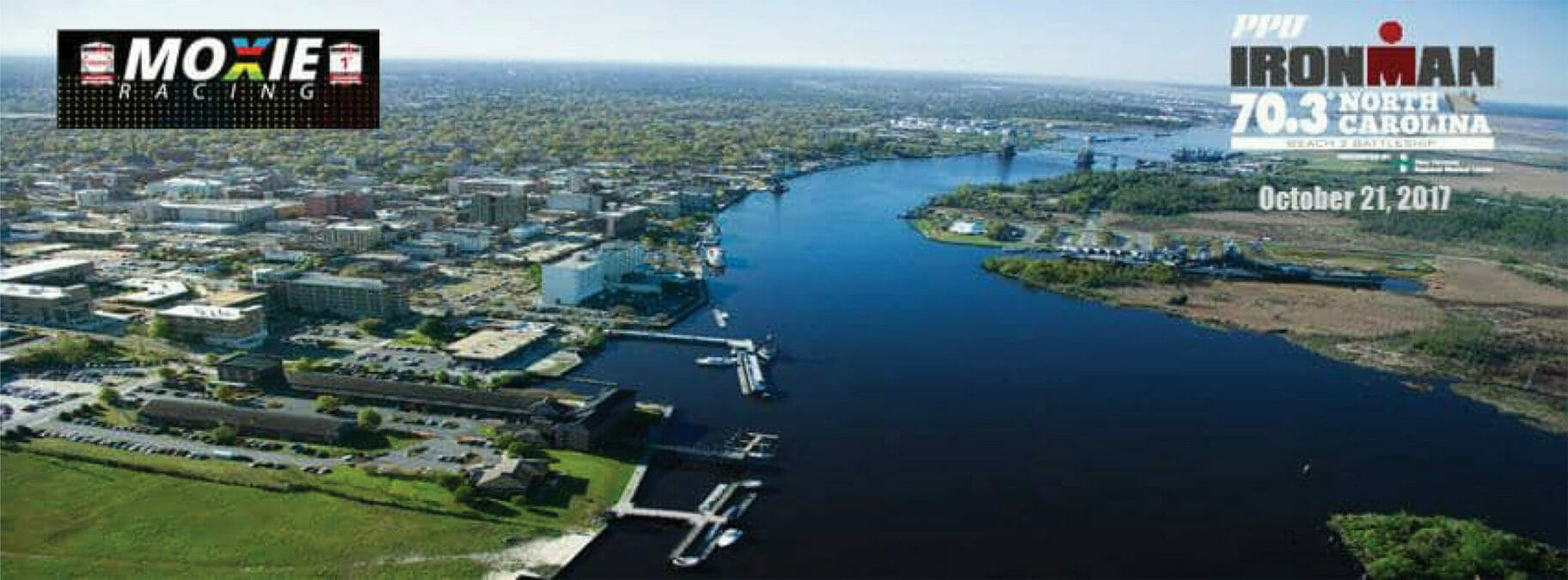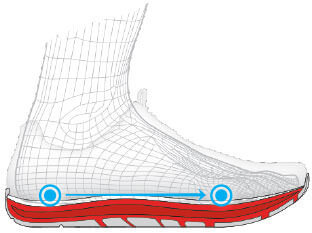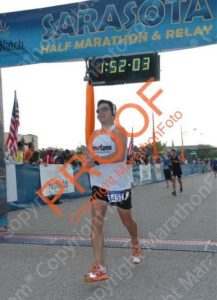
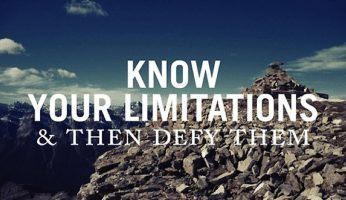
Tri Tip Tuesday: My MOST Important Running Tip
On Tuesdays and/or Thursdays, I will do my best to give one simple fitness, triathlon or running tip, trick or piece of information that will provide some value to in either helping you to become more efficient, prevent injury, increase performance, have more fun or at the minimum give a review of knowledge that might not have crossed your path in a some time.
I find myself observing other runners while running and sometimes just hanging out here in Tampa. Due to the weather here lending itself to year-round training, I have no shortage of material to choose from.
My #1 Most Important Run Tip
My coaching practice’s number one priority is form, technique and injury prevention, so I routinely use other runners, with my clients to reinforce the form training I have provided. (Sorry, Tampa runners. If you happen to pass by me with a client, most likely you have been observed and surveyed for comparative analysis.)
With all of my observations, the number one issue that I see are runners that sit in the bucket. Of course, the question most people ask is what does sitting in the bucket mean?
Basically, it’s when the glutes(or bum) are not in line with the torso. The body looks like an “L” from the torso to the hamstrings. Natural running which when learned is much easier, more efficient and greatly reduces impact on the joints. The torso hips, glutes and ankles form a straight line.
[table “2” not found /]
The interesting thing is, that running should be instinctual right? Unfortunately, not anymore. Sociological factors have played into our bodies to a point where most Americans, cannot just decide to take up running without going through periods of injury.
For example, sitting at a desk all day will tighten the hip flexors so that it becomes extremely difficult to push the hips under the torso. The same thing is evident for playing video games on the couch for long periods of time.
The figure on the left is actually still a lot better than I have noticed out and about. The torso is still tall and the chest is still has a little bit of lean to it causing forward motion. A lot of runners I notice, sit in the bucket and lean back. What is this doing? Basically, gravity is working against the runner. The objective is forward motion but the glutes and the torso are sitting back, so in essence, the body and gravity are working against itself.
Another perception you will see is the heel strike of the runner. When that heel strikes the ground the impact reverberates all the way from the ankle through the legs, spine, neck shoulders and head. This is where most of the injuries take place.
By simply starting to incorporate, tilting the hips under the torso and leaning from the ankles instead of the waste, the body will start allowing gravity to be used instead of the legs as the sole source of momentum. Suddenly, the feet are striking the ground underneath the center of gravity and only the calf down to the metatarsals absorb the majority of the impact from the ground.
I continue to instill in my clients, running is powered by the core, not the legs. Use gravity as momentum and allow the legs to just go for the ride. To remain consistent, the core must be strengthened and hip flexors stretched to keep the glutes from returning to the bucket.
There are many techniques to help modify the behavior to allow for an efficient, safe and effective change of form. All it takes it the will to want to change and get better and you will.
The #1 tip – get out of the bucket.
Are you running in the bucket?
Did this information shed some light on any area of your running that might be in need of improvement?
Carpe Vitam!
(Seize Life!)
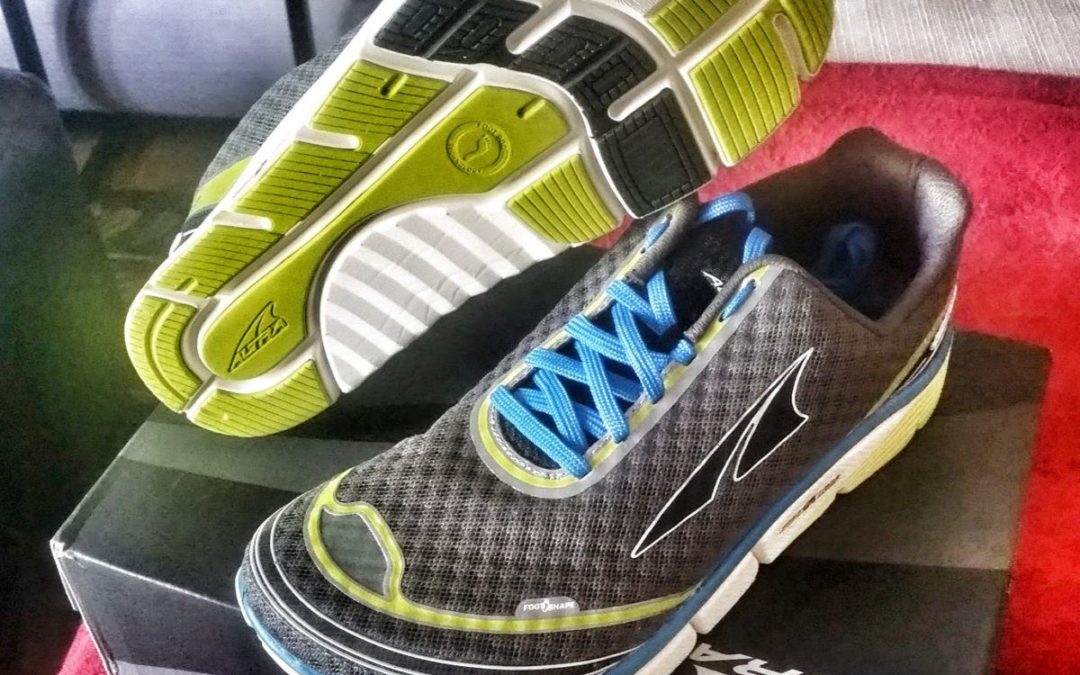
Goof Review: Altra Torin 2
I have been a fan of the Altra line for a little while now, so I was so honored to be given a chance to review the brand new Altra Torin 2. I reviewed the 1.5 version when it first arrived, and it became my shoe of choice for long runs.
What I love about the Torin 2
Zero Drop
One of Altra’s significant differences in the complete line of shoes is their zero heel drop and since my coaching methodology includes an emphasis on our body’s natural movement while running this is obviously one of my favorites. (I have included a explanation of what “Zero Drop” means in my previous Altra Torin 1.5 review.)
Wide Toe Box
The other difference between Altra and their competition is the wide toe box, or as Altra calls it, a “FootShape” toe box. The ability to splay the toes plays a significant role in injury prevention and the strength of the feet. This allows the runners body to support itself, rather tan relying on a shoe for support.
Upper
The upper has been improved in the 2.0. The Torin 1.5 was made with a thick upper which added unnecessary weight and reduced flexibility of the shoe. The 2.0 has been upgraded with a much thinner mesh material that breathes better and allows for more flexibility.
Outsole
Here is where some of my favorite changes were made. First, they moved from the heavier EVA to their lighter proprietary “A-bound” material that for me seems to add a little more spring to the ride of the shoe. When my foot strikes the ground the material seems to not only protect from the natural impact, but reacts driving me forward.
The weight in the previous show was 10.1 ounces which was up from the original Torin which was 9.5 ounces. The Torin 2 comes in at 9.1 ounces which is one of the lightest in this category, if not the very lightest.
Midsole
Altra added what they call Innerflex which are groves in the outsole and midsole that bend with your foot allowing substantially more flexibility than the previous models. This too me was the single most important change they made. The Torin has always classified as their High Cushioned shoe which most companies have traded flexibility for cushion. Altra has found a way to give runners the flexibility I love with the cushioning I want and without giving up any of proprioception.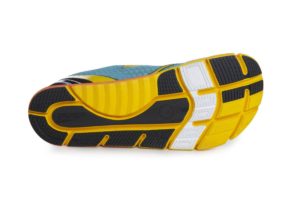
The have now included a Foot Pod technology which maps the bones of the foot with the Innerflex so the shoes flexes where the runner needs it to, allowing a near customized fit.
Removed
Altra went ahead and removed the toe guard and heel rudder as well. In my opinion this not only allowed them to shed some weight, but also added to flexibility and comfort. In a road shoe I never really thought either added any value. These two advantages are best left for trail specific designs.
What I don’t like about the Torin 2
Obviously, not much.
The new Abound foam tends to soak in water and sweat which makes the shoe feel a little heavier during training and racing. Even with the mesh material the shoe does not seem to drain well. I would love to see a version of this shoe with drain holes, but of course that is the triathlete in me talking.
After about forty miles the new Abound material started to squeak while just walking ,and only in my left shoe This does not seem to happen when I run in them, but it is a little noisy when walking through the store. I think it may be just a problem with this pair, but nonetheless it is something I dislike. However, it did not change the performance of the shoe.
The price of $125 is a little high in my opinion. A better price point would be the $100 – $110, but of course that is very minor for shoe of this quality.
Let’s see how the Torin 2 ranked on my scale:
Quality – 4/5
Upper – 4/5
Outsole – 4/5
Flexibility – 5/5
Comfort – 5/5
Appearance – 4/5
Overall – 4/5
The Altra Torin 2 is available in men’s whole and half sizes 7-12.5, whole sizes 13-15 and in three color patterns. It is available in women’s whole and half sizes 5-10.5, whole sizes 11-12 and in three separate color patterns.
Have you ever ran in a pair of Altra Torins (any version)? How did you like them?
Please feel free to comment on your feedback.
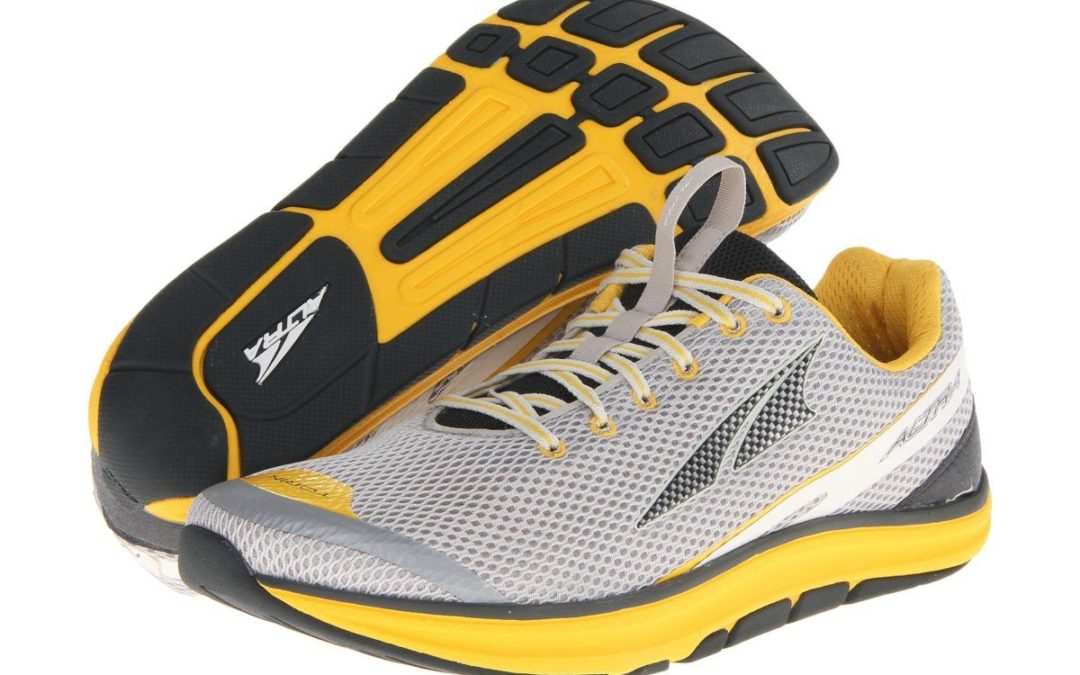
Goof Review: Altra Torin 1.5
The quest for the best running shoe can be daunting, but the search for the best zero drop running shoes can be downright frustrating. The majority of all the Altra Zero Drop reviews I personally have read, the consensus is pretty positive, and in this instance, it will be no different, because in my opinion, it has resolved my issue of finding the best zero drop shoe on the market. The Altra Torin 1.5.
What is Zero Drop?
To define zero drop is to first define heel drop, which is the difference between the height of your heel off the ground minus the height of the ball of your foot. For instance, most of the traditional running shoes out there have a 12-millimeter drop.
The heel is raised 12 millimeters above the ball of the foot. This causes more emphasis on the heel when running because that is where most of the cushioning is. A more minimalistic shoe will have a drop that is much lower.
For instance, the Brooks Pure Flow has a 4 mm drop. This shoe is great for starting the transition to a more minimal shoe giving all the benefits of a minimal shoe without causing the injury of the drastic change from traditional to minimalistic.
The Altra Torin 1.5 is a complete zero drop where the ball and the foot and the heel are equal keeping the foot more natural like walking barefoot. While it has the zero drop of a minimalistic running shoe, it does provide the protection of a good amount of cushioning in the sole. This is one of the reasons I truly enjoy running in this shoe.
Upper
The upper is durable but is thick throughout. I personally like this, because I feel the security of the shoe without having to pull the laces tight. In my opinion, the laces should never be tight. Once the laces are tied they should really never have to be untied unless you are using a runners lace. The laces should be tight enough to secure the heel but no more. This allows the runner to support themselves rather than the shoe supporting the runner.
The Altra 1.5 has the same wide toe box that is consistent with the whole line of zero drop running shoes. I love the wide toe box because it allows me to have splay my toes and grab the road with more surface area. My feet do not feel crowded in this shoe.
Altra changed the laces in the 1.5 from the original model. They are now flat vs the round nylon laces and they reduced the number of holes on each side from 7 to 6. It provides more space between the touch of the laces to the foot and security in the sinch of the laces.
The shoe also seemed to have less seems and the addition of a strap that cinches the tongue to the upper. It helps the security of the foot in the shoe.
Outsole
The outsole has not changed from the original Torin, but that is something I personally liked. There is enough cushion in the sole for protection without losing the feel for the road or trail underneath.
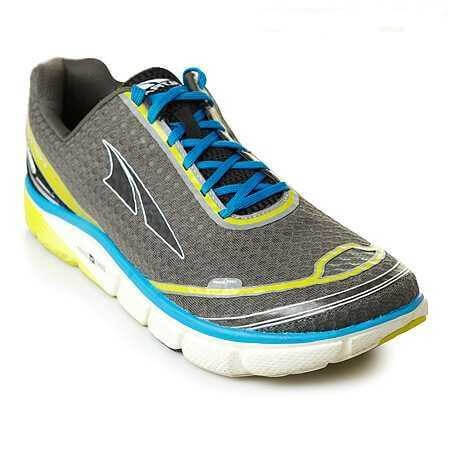
Altra Torin Original
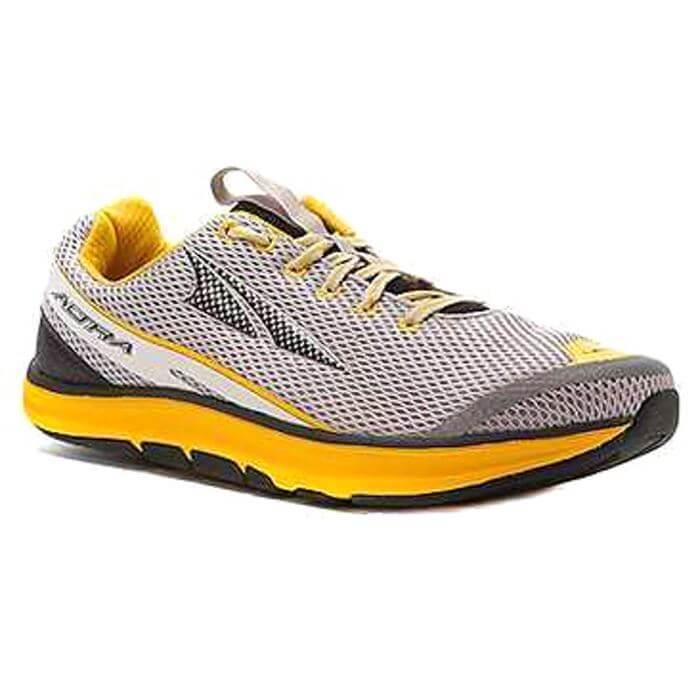
Altra Torin 1,5
The ride of this shoe is extremely comfortable. Of course, this is why I enjoy the Altra line in the first place. The ride is smooth with great responsiveness on the road.
The interesting part of the shoe is the weight. When upgrading a shoe from an original version, the thought would be that the weight could be dropped, but in the new Torin 1.5 has an extra ounce added. The shoes weigh 10.5 ounces versus the original Torins at 9.5 ounces.
The flexibility has not changed either. The Altra Torin or the Torin 1.5 are not the most flexible of shoes, but they do have enough flexibility to give a good lever and lift from the ground. I am chalking the lack of flexibility to the design of the shoe being for the road and not the trail. Trail shoes should have a little more flexibility for the technical terrain.
Appearance
I do like the color of these versus the originals. The blue and orange weren’t bad, but they went a little more conservative with the grey, yellow and black. This is obviously a personal choice on the runner, but I thought I would put my two sense in.
The cost is a little more expensive at $120 dollars, but the shoes seem to last over 400 miles which most shoes will only last 250 to 300 before losing the cushion and ride comfort.
My Impressions:
Quality – 4/5
Upper-4/5
Outsole – 4/5
Flexibility – 3/5
Comfort – 4/5
Appearance – 4/5
Cost – 3/5
Have you tried the Altra Torin or the Altra Torin 1.5? Have you run in any of the Altra lines of shoes? What do you think? Please let me know in the comments below.

Catching up with the Goof #3
As stated in web-ease “O-M-G!” I have so much information to share It is hard to think about anything else. Unfortunately, I started on a new contract a couple of months ago and now that I am fully immersed in it, my days are becoming hectic. Not only that but I have my own training, coaching clients and getting ready for the CPT test this month, so needless to say hectic is the only word to describe my activities right now.
Have you noticed the new change to IronGoof.com? I have moved away from a complete blog site to a more of a Coaching Site. I hope you like the new looks. Please feel free to explore and send some feedback on the changes. It will continue to be a work in progress, so any and all honest comments on the site are very welcome and encouraged.
Coming up over the next weekend or so I am going to be sharing news about past events and the latest going’s on.
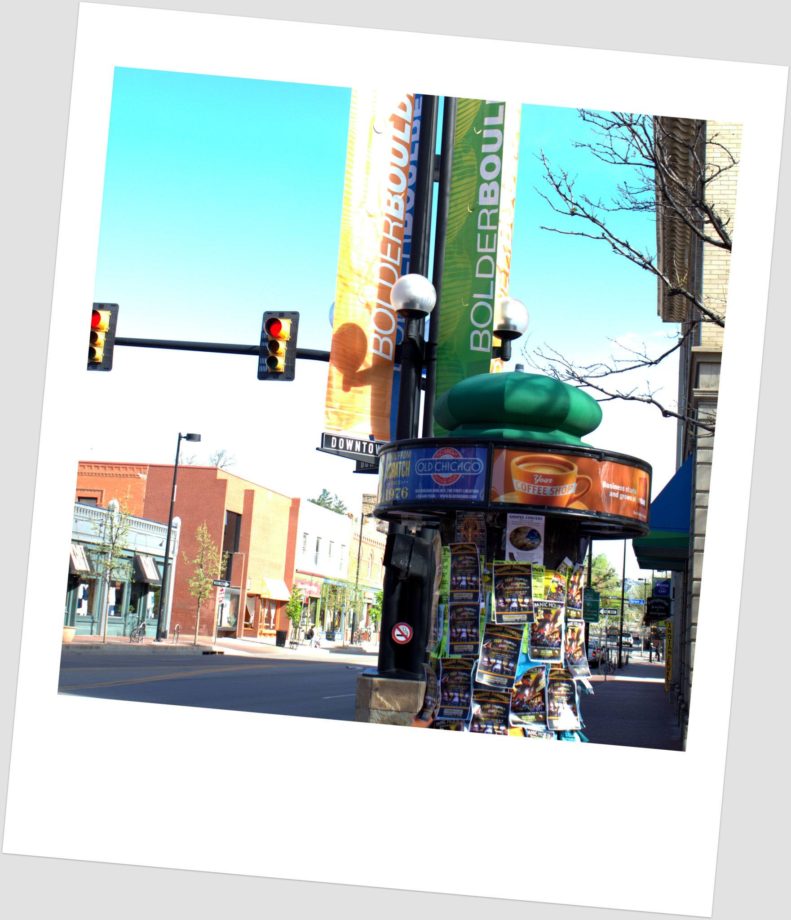 I just returned back from Boulder, Colorado where I spent five amazing days working some of the top running coaches on form and performance. The Newton Running Lab hosted certification training for RRCA, Newton and Lydiard. The content included proper running form with drills, strength exercises, injury prevention, injury management and transition plans. While I was intrigued with the Newton Coaching formula, I was excited that a portion of it mimicked my own. The only part that my personal coaching methodology added was the intricacies of making the running form personal to each person. Newton believes proper running mechanics are the same for everyone, and with the hundreds of hours I spent learning my own body I know this isn’t true, but it is a good place to start.
I just returned back from Boulder, Colorado where I spent five amazing days working some of the top running coaches on form and performance. The Newton Running Lab hosted certification training for RRCA, Newton and Lydiard. The content included proper running form with drills, strength exercises, injury prevention, injury management and transition plans. While I was intrigued with the Newton Coaching formula, I was excited that a portion of it mimicked my own. The only part that my personal coaching methodology added was the intricacies of making the running form personal to each person. Newton believes proper running mechanics are the same for everyone, and with the hundreds of hours I spent learning my own body I know this isn’t true, but it is a good place to start.
The Lydiard Certification training was the best part. Arthur Lydiard was a New Zealand running coach that coached many Olympians to medals including gold in the 1500 meters and beyond. He later mentored other coaches to a point where he is actually considered “The Coach of Coaches of Champions.” Obviously, this resonated with me because Arthur himself was not a competitor, but he coached more champion runners than any other coach to this day. As I really do not compete with anyone other than myself for PRs, this validated my feelings on coaching and my passion for it. As this is a coaching method, not a form method, it also validated a lot of what I already incorporate, but I also enhanced my knowledge greatly.
It was taught by Lorraine Moller who herself was a three time Olympian to include racing in the first 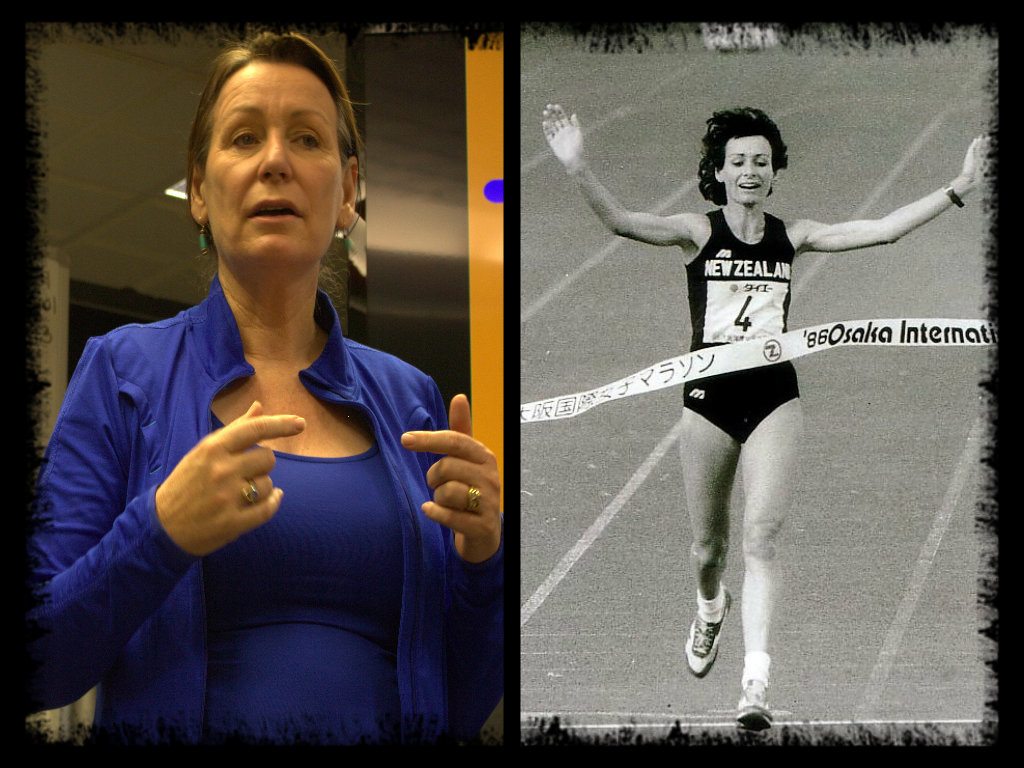 ever Olympic Women’s Marathon in 1984 where she took 5th. She did won bronze in 1992 at the Barcelona games in the Women’s Marathon. Her credits also include winning Grandma’s Marathon three times, the Boston Marathon, the Osaka Ladies Marathon twice, the Hokkaido Marathon twice, and second in the Commonwealth Games. She was coached by John Davies who was mentored by Arthur Lydiard. Lorraine herself was followed by Arthur and would consistently give her pep talks before competition. She is an amazing speaker and completely passionate about running and the Lydiard Coaching method as well as the founder and president of the Lydiard Foundation. I was extremely lucky to have someone as accomplished as she is as an instructor for the class.
ever Olympic Women’s Marathon in 1984 where she took 5th. She did won bronze in 1992 at the Barcelona games in the Women’s Marathon. Her credits also include winning Grandma’s Marathon three times, the Boston Marathon, the Osaka Ladies Marathon twice, the Hokkaido Marathon twice, and second in the Commonwealth Games. She was coached by John Davies who was mentored by Arthur Lydiard. Lorraine herself was followed by Arthur and would consistently give her pep talks before competition. She is an amazing speaker and completely passionate about running and the Lydiard Coaching method as well as the founder and president of the Lydiard Foundation. I was extremely lucky to have someone as accomplished as she is as an instructor for the class.
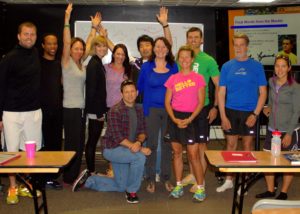
The class was kept fairly small in order to provide us with a lot of individual instruction. We went through analysis of our own form using video which was really interesting. I know that my form isn’t perfect, but my mechanics are good. I found that I actually do not lift my knees as much as I should, and when I applied it later the form became even easier. I learned a lot and I hope to attend the level 3 class later in the year.
Boulder as a city was awesome!!! The scenery was amazing as it was surrounded by mountains and the culture really resonated with me. Boulder’s environment seems to revolve around two things, athletics and the arts. Which are my two passions, so this city really got under my skin. Everywhere you go, everyone is traveling on bicycles and avid cyclists and triathletes are training. Pearl Street is filled with small businesses, to include, coffee shops, restaurants and bars, and none of them are chains. You cannot find a McDonald’s or Wal-Mart anywhere the residents won’t allow it which is great. The quad-like feeling of this outdoor “mall” for lack of a better term, is filled with musicians playing and practicing, photographers, writers, and artists. It gives the feel of a old small town but with the University of Colorado in the midst, it also brings in a younger element that increases the energy of the area. The weather started the day in the high 50s and increased to the mid 80s and then ended in the high 60s. There is almost no humidity, so the air smells fresh and clean. Since most people utilize people-powered transportation it feels as though exhaust fumes do not even exist. I just fell in-love with Boulder and Colorado. I am not quite sure I ever want to live in a place with winter months, but if I did, I definitely would consider Colorado and Boulder.
My plan is to sit and complete the few posts I have started this weekend to bring you the following:
- Race recaps for: Tampa Bay Corporate 5k, Escape from Ft. DeSoto, Saint Anthony’s Triathlon, the Police Appreciation Run and Miles for Moffitt.
- I have a guest blog post, and a corroboration post that will both prove very interesting.
- Product reviews on: The Newton Terra Momentum running shoes, the Mizuno Evo running shoes, the Nike Free 5.0 running shoes, Entrade-S -R pre and post workout supplements, Chia Power Gels, and Champ-Sys Tri kits.
- Tribute post for Lorraine Moller
- New campaign of entries called the IronGoof-Lydiard Experiment..more to come on that.
That should keep me busy for a while. Have an amazing week! Live with Passion.
Carpe Viam!
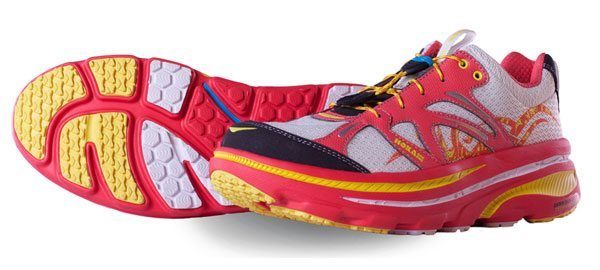
Goof Review: Hoka Biondi S2 Running Shoes
Hoka One One Biondi S2
Have you ever even heard of these shoes before? I didn’t before I met Chet “The Jet” whom was a double Ironman athlete I hosted in my home a few weeks ago. Chet is from Hawaii and he nonchalantly mentioned these shoes as he was telling the tale of his son whom was running across the country. He was even went on to mention that he sent a pair to a point in Alabama where he knew he son could pick them up, and the response, nothing but sure gratitude for the gift. That was the point I had to give them a try.
Hoka One One is not well known here on the east coast, but in the community of ultra runners they have been known since their inception in 2010. Obviously this is a relatively young company which falls under the Deckers Outdoor Corporation umbrella whom also houses brands like UGG, and Teva. With the increased popularity of Ultra and Marathon running, I believe these will take off to even higher levels in the very near future. Why? Well let me tell you.
When I looked at these shoes for the first time, I reacted negatively. The huge sole, was a 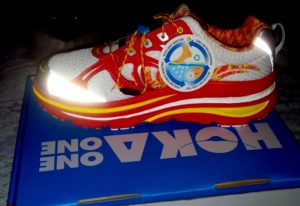 problem for me, due to my belief in a more of a minimal running form, but I for the readers and for my clients I wanted to give them a try, especially after the rave reviews from Chet and his son. I decided to take them out first for a three-mile run, and then give them a full test drive at the Sarasota Half-Marathon this past Sunday. I was completely overwhelmed at how comfortable and responsive these shoes are. At first glance they look really heavy don’t they? They weigh in at slightly under 10 ounces(9.8), which is the exact weight of my Brooks Pure Flow 2s that I love so much. My Brooks Pure Cadence 2s, I was just sent are actually almost 0.4 ounces heavier. (Just a disclaimer, I weighed these myself, I did not take these stats from the website.)
problem for me, due to my belief in a more of a minimal running form, but I for the readers and for my clients I wanted to give them a try, especially after the rave reviews from Chet and his son. I decided to take them out first for a three-mile run, and then give them a full test drive at the Sarasota Half-Marathon this past Sunday. I was completely overwhelmed at how comfortable and responsive these shoes are. At first glance they look really heavy don’t they? They weigh in at slightly under 10 ounces(9.8), which is the exact weight of my Brooks Pure Flow 2s that I love so much. My Brooks Pure Cadence 2s, I was just sent are actually almost 0.4 ounces heavier. (Just a disclaimer, I weighed these myself, I did not take these stats from the website.)
What also surprised me was the structure looks like a normal running shoe, like any Asics Nimbus, or Brooks Ghost which has a 12mm heel drop. They say looks can be deceiving, and with these shoes they are. They also have the same heel drop as the Brooks Pure Project line as well. The flexibility in the forefoot is probably the only disadvantage of this shoe versus my own running shoes and even that is minimal, and I believe probably after running in them for a little longer even that would become pliable enough to create more flexion.
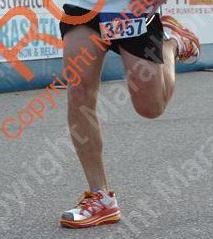 The sole not only provides superior cushioning upon impact, it also is slightly wider which increased the stability as well. It seriously was like running on a cloud. I always preach good running form, and if you have naturally good form, impact is not usually an issue due to a proper lean, raised knee, and high cadence. I found myself not having to think about my posture and position, because the rocker-ed sole of the shoe did not inhibit, but encouraged a good strike and lean. Just for the fact a few of my clients are still trying to get into the habit of good form, I decided to jump rope, and do some box jumps in order simulate the impact. I barely felt anything, and I had full control of my feet. i really thought I would end up kicking the rope especially doing double-unders, but I had complete control and I barely felt the impact doing the box jumps. I could totally understand why these shoes are so popular with the marathoners and ultra-runners on the other coast. The more people start wearing them here, I believe they will gain popularity pretty quickly.
The sole not only provides superior cushioning upon impact, it also is slightly wider which increased the stability as well. It seriously was like running on a cloud. I always preach good running form, and if you have naturally good form, impact is not usually an issue due to a proper lean, raised knee, and high cadence. I found myself not having to think about my posture and position, because the rocker-ed sole of the shoe did not inhibit, but encouraged a good strike and lean. Just for the fact a few of my clients are still trying to get into the habit of good form, I decided to jump rope, and do some box jumps in order simulate the impact. I barely felt anything, and I had full control of my feet. i really thought I would end up kicking the rope especially doing double-unders, but I had complete control and I barely felt the impact doing the box jumps. I could totally understand why these shoes are so popular with the marathoners and ultra-runners on the other coast. The more people start wearing them here, I believe they will gain popularity pretty quickly.
The retail price of the Hoka One One Biondi S2s are $170.00 which seems even high for a running shoe, but like the Newtons, they have a much higher mileage output. In my research I have found these shoes have been averaging over 700 miles without any degradation of the sole or cushioning. An ultra runner friend of mine said he had 3 pair of these he was switching out, and his current count is at 3048 miles and he has no intention of getting new ones yet. Most running shoes will get up to 350 miles, and my favorite Pure Project line rates there own shoes at 250 miles and cost around $100 retail.
They do take some getting used to. They do feel bigger, but not heavier. I do like that I was 5’11’ with them on, instead of 5’8″ and change. Personally, I do not think I would use them for a half marathon or below. I like the feel of the road a little too much, but you better believe I will be running the Chicago Marathon in them.
I give the Hoka One One Biondi Speed 2s, 4 out 5 Goofs.
Hoka One One has several other versions of shoes, for different fits, and surfaces. More information can be found on their web site.

